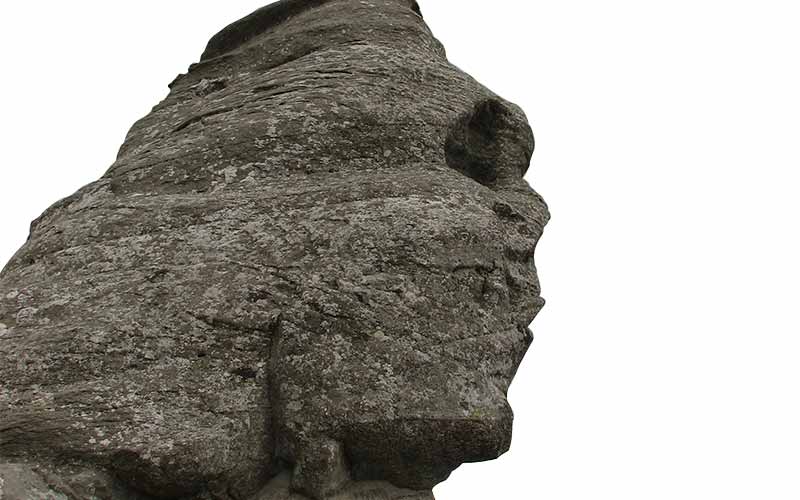Rhytidoplasty
THE GOAL:
To smoothe out and improve the most visible signs of aging on lower two-thirds of the face. This includes the jowls, the “drawn out” sagging midface, jawline and neck.
TERMINOLOGY
A number of procedure variations fall under the rubric of face lift. To clarify:
FACE LIFT (rhytidoplasty, rhytidectomy or meloplasty) is the classic lay term for a traditional face lift which is supposed to improve the lower two-thirds of the face (plus the neck) The incisions are generally placed inside and around the ears.
The procedure rejuvenates the face and neck by removing selected localized fat bulges (e.g. jowls) while resuspending others (the malar fat pads along with the nasolabial folds) and tightening deeper sagging structures (e.g. muscle and connective tissue-SMAS), concluded by a skillful redraping of the skin.
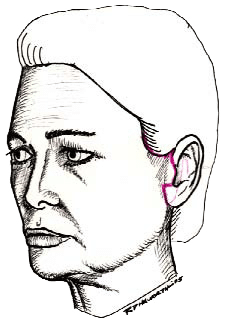
CAUTIONARY WORD:
The traditional face lift represents the gold standard by which all other facial rejuvenation surgeries are measured. Lately, there’s been a lot of promotion for branded (that is, procedures that are trademarked, registered or copyrighted) short scar or other face lifts. Be aware of marketing for procedures that might not be very beneficial in the long run, and may in some cases, actually be harmful. While they promise and deliver surgeries in under an hour with local anesthesia, faster healing times and shorter scars, what they cannot do is achieve the satisfying long-term results of the more thorough approach of a classic face lift. Indeed, many of these “quick-fix” procedures result in bad skin draping, puckered closures, thick permanent ropey scars (albeit shorter!), altered hairlines, distorted ear canals and pulled-down ear lobes, all of which have to be corrected by subsequent surgery.
MID-FACE LIFT (subperiosteal endoscopic face lift) refers to the middle third of the face, that is, the area around the nose, beneath the eyes and around the mouth. 2 cm incisions behind the temporal hairline allow the use of an endoscopic (andmicroscopic) camera to guide tiny instruments that accurately lift and reposition the cheek and the soft tissue planes in a youthful manner.
CANDIDATES
The most appropriate candidates for a classic face lift are those who:
- Have a well-defined bone structure but whose face and skin are slack and sagging due to age or extreme weight loss. Everyone has a different threshold when they are bothered by their signs of aging and consequently seek treatment. Some do it as soon as mild evidence of jowls appear while others wait until they develop a significant “turkey neck”.
- Are in good health
- Have reasonable expectations
EXPECTATIONS
Of course, individual results can vary, but a classic face lift will deliver a smooth, fresh, rejuvenated look that can last for years. However, it can’t stop the clock. Depending on how you age over time, you may safely touch up the procedure one or more times, perhaps seven to fifteen years down the line. Adjuvant therapies such as advanced fractionated laser treatment, fat transfer, lip lifts, etc. can also be employed to optimally maintain your new visage.
A classic face lift can:
- Lift sagging cheek skin and accompanying deep soft tissue
- Soften naso-labial folds
- Smooth jowls and mariotte grooves
- Tighten and smooth neck and face skin
- Recontour the jawline and neck
- Decrease neck bands (platysmal)
What a face lift cannot do is:
- Correct aging of the eyelids and brows
- Eliminate all facial and neck wrinkles
- Rejuvenate the oral region, including sagging of the corners of the lips
Patients may choose to have a face lift in conjunction with other rejuvenating procedures such as a mid-face lift, forehead (brow) lift, eyelid surgery, chin implant, cheek implant or nose reshaping. Indeed, Dr. Haworth may sensitively recommend these if he feels it appropriate.
NEW TECHNIQUES VS. OLD THINKING
Dr. Haworth’s face lifts are significantly more sophisticated than in generations past, resulting in far more subtle, natural and yet effective outcomes than ever before.
These breakthroughs include:
FIRM NOT TIGHT: The old ‘wind tunnel’ effect occurred by pulling and securing the skin without addressing the fat, muscle and connective tissue beneath. By correcting compromised deep facial structure, Dr. Haworth is able to deliver far more natural-looking and long lasting results.
TAILORED TO FIT: Old techniques relied solely on skin stretching with no “muscle tightening” or on maximal “muscle tightening” with minimal skin redraping. Dr. Haworth feels that there is no one single formula that can be applied to every face. There are many types of face and many different patterns of facial aging: Some faces are heavy and some are thin; some have “turkey necks” with mild jowls while others have relatively contoured necks but obvious jowls; some skin is thick while other skin is fragile. Understanding this wide spectrum of facial types has led Dr Haworth to analyze each face with his multidimensional approach. His unique method of surgical facial rejuvenation is more visual than mathematical. He realizes that the deeper structures must be suspended more vertically (since human faces tend to sag vertically) whereas the skin must be redraped at a slight tangent- a bivector suspension. Dr. Haworth simply refers to his method as a modified classic or traditional facelift, in which he employs a 270° skin redrape, customized “high SMAS” technique along with judicious defatting of the jowls and a z-plasty corset platysmaplasty.
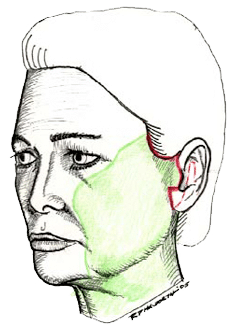
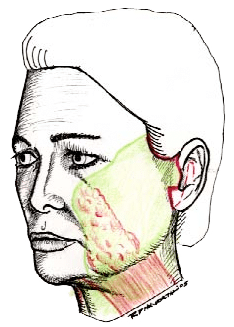
However, there is nothing old-fashioned about it.
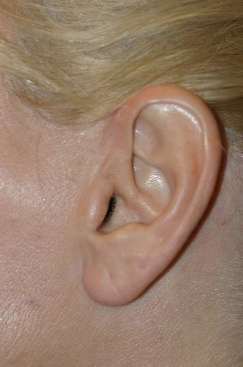
VOLUME EQUALS YOUTHFULLNESS: Skin with a plump elasticity and pleasing contour is the most youthful-looking. Previous generations tightened skin without restoring volume. Today, Dr. Haworth spends as much time restoring and repositioning the three dimensional planes of the face and neck as he does to smoothing and tightening the skin.
SINGLE-STITCH CLOSURE: Unlike most surgeons, Dr. Haworth takes extra time in closing his incisions both in front of and behind the ear with a single, unseen suture. This can be likened to the thread rendered invisible in the seams of a dress.
PERFECT MATCH: Dr. Haworth calls himself an expert micro-tailor when closing the incisions around the ear. He must expertly trim excess skin to the exact size and shape to conform to the unique nuances of the ear anatomy. Consequently, healing should occur with minimal-to-no tension resulting in near invisible scarring and nearly zero distortion of the hairline and ears. No tension for perfect draping and closure.
TAKING TIME: No short cuts, surgery takes time and patience to get it right.
PRE-OPERATIVE CONSULTATION
The pre-operative consultation is where you meet with Dr. Haworth and our staff to review your health, finalize the details of your procedures, order appropriate tests, prescribe medications, discuss your aftercare and answer any questions you may have.
All patients are required to take standard blood tests within 6 weeks of surgery. This can be arranged at the same time as your pre-op consultation.
To the consultation, we ask that you bring the following:
- Any appropriate health records related to the list of conditions noted above.
- Photographs of you when you were in your teens, twenties and thirties.
For patients over 45, we may also require that you provide the following:
- Full medical clearance
- EKG
CRITICAL PRE-OP CAUTIONARY NOTE
It is absolutely essential that that you avoid all aspirin, aspirin-related, ibuprofen or blood-thinning medications for 2 full weeks prior to your surgery. In your pre-op consultation, we will give you a complete list of these drugs. For our patients, we also provide a password-protected link allowing you to download the list onto your computer from this web site. If in doubt about a specific medication, do not take it, call the office first and ask if it is on the forbidden list.
If your hair is very short, you might want to let it grow out about an inch before surgery, so that it’s long enough to hide the scars behind the ears while they heal.
PROCEDURE AND RECOVERY LOGISTICS
SURGERY DURATION: 2 to 4 hours, depending on the extent of the work and what other procedures you are having done at the same time.
ANESTHESIA: General or sedation (“twilight sleep”) we will do everything we can to keep you comfortable. An anti-emetic (against nausea) medication is also administered while you are asleep. We not only provide pain medication to control what little pain you may experience postoperatively, but you will be additionally prescribed anti-anxiety, anit-nausea and sleeping pills to maximally ensure your comfort and safety.
SUTURE REMOVAL: 5 days after surgery for the first set and 10 days for the second As you wake up from surgery, your face will be exposed, your head and neck will be bandaged with a chinstrap, there will be drains behind your ears and you should be in minimal pain. Expect to stay in the recovery room for an hour before the town car takes you to your aftercare facility.
By the third week, you’ll look and feel much better. Most patients are back at work about 7-14 days after surgery. If you need it, special camouflage makeup can mask most bruising that remains.
Gradually, you will be able to resume to your normal activities:
- 1-3 DAYS read or watch television
- 7 DAYS resume wearing makeup (most bruising will be gone)
- 7-10 DAYS be out in public, back to work and take long strolls
- 3-4 WEEKS begin moderate and work up to vigorous exercise
MINIMIZING SCARS
Your face lift scars can be easily hidden by your hair or in the natural creases of your face and ears. In any case, scars in and in front of your ears will start to fade in the first week and should be scarcely visible by about 14-21 days. Scars in the back of the ears generally take several months to resume their natural texture and color but they too should fade to invisibility.
Visible scarring can also be kept to a minimum by:
- Following all post-op instructions to the letter
- Avoiding pulling and tension
- Sleeping on your back
- Using silicone scar gel (available in our office)
- Avoiding all sun exposure on your face, neck, decolletage, and neck
- Getting your facelift performed by a reputable surgeon
Post-Operative Care
A face lift is one of the three procedures (a tummy tuck and major liposuction are the other two) where you must stay in an aftercare facility for at least a night after your surgery.
In person and in your post-op information packet, we shall explain everything you need to know for your aftercare at home that will include:
- Medications (prescription and homeopathic)
- Cleaning incision sites
You will need to keep your activities to an absolute minimum for at least 3 days.
For the next few weeks, expect to tire easily. To aid your recovery you’ll want to rest as much as possible and:
- Treat your face and hair gently, since your skin will be both tender and numb
- Ice your face every few hours for 2 days following your surgery
- Keep your head gently elevated (above the level of your heart), even while sleeping
- Avoid strenuous activity – including exercise, heavy housework – for at least 2 weeks. Abstain from sexual activity for a week and when you do resume it, commence gradually and rather passively.
- Avoid steam baths, and saunas longer than 5 minutes for at least 6 weeks or until the doctor gives you the OK
- Avoid alcohol and aspirin products for 2 weeks
- If you don’t feel dizzy, slow walking and mild stretching are fine as long as you do not bend over
During healing, you may experience:
- Swelling as well as facial numbness. These are only temporary but may be annoying to some. However, some facial swelling tends to impart a youthful glow that many patients are partial to.
- Bruising is fairly mild to minimal following a facelift, but when it does occur, it usually takes about 10 to 21 days to completely fade away.
To optimize and accelerate healing, we also recommend coming into the office for hyperbaric oxygen treatments and Bioptron™ polarized light therapy. Both of these modalites can reduce swelling and bruising by up to 5-7 days. Additionally, these exhibit significant healing properties upon slow-healing incisions and injured skin.
One can don only certain types of eyeglasses after surgery. Dr. Haworth must approve them before you start wearing them postoperatively. Alternatively, one can utilize any eyeglasses if they are taped in such a way onto the forehead to minimize the frame from wrapping snuggly behind the top of the ear.
Risks & Challenges
Conditions that make a face lift more of a challenge and may require additional consent from the appropriate medical specialist include:
- Serious health issues such as diabetes, uncontrolled high blood pressure, heart disease, collagen vascular disease
- Blood clotting problems
- The tendency to form excessive scars
- Smoking
No surgery is entirely risk-free. However, both our staff and facilities have the highest possible qualifications to produce a happy outcome.
While risks and complications are very uncommon, be aware that those for a face lift can include:
- Hematoma (a collection of blood under the skin, 7 times more common in men than women). If this does occur, it generally does so in the first night after surgery and will require a simple procedure to correct it.
- Injury to the nerves that control facial muscles which is extremely rare and, fortunately, temporary.
- Infection (exceedingly unlikely)
- Poor healing (most likely to affect diabetics and smokers)
FAQS
1. I AM CONFUSED DOCTOR. THERE ARE SO MANY TYPES OF FACELIFTS. WHICH ONE IS RIGHT FOR ME?
This is understandable since it can even be confusing to Plastic Surgeons! One must first understand that the face is arbitrarily divided into thirds. The upper third represents the upper eyelid and brow. The middle third is the area from the lower eyelids to the corner of the mouth. This includes the nasolabial folds and under eyelid hollows. The lower third is measured from the corner of the mouth past the jawline onto the neck.
An endoscopic brow lift addresses the upper third. These are done through 4 small incisions behind the hairline with a small camera and specialized instruments.
Only a traditional/regular facelift (one which involves incisions in and around the ear) rejuvenates the lower 2 areas.
A midface lift (AKA vertical lift, subperiosteal lift, Minimal incision lift) effectively reverses aging in the midface ONLY – the jowls and neck will not be helped by this latter technique alone. The Midface lift involves hidden incisions within the hairline and mouth and is possible through the use of small cameras and an Endotine device (Coaptsystems.com). It is ideal for those that want subtle changes who are in their midthirties to forties. Sometimes a midface lift will be combined with a regular facelift for an enhanced result. I will listen to your concerns and devise a customized surgical strategy depending on the state of your tissue and your specific goals.
Thread lifts (Contour ??and Feather Lifts??) are interesting new concepts in facial rejuvenation. Barbed sutures (like fishing line) are threaded through and hooked into the superficial facial tissue under local anesthesia and then pulled upwards. However, results so far do not match up to either regular or midface lifts in terms of efficacy or longevity. They last only about 18 months, but they may be appealing because no significant incisions are involved, they can be performed under local anesthesia in a dental chair and are relatively less expensive.
2. YOU DIDN’T MENTION THE SHORT SCAR FACELIFT, MACS LIFT, S.O.M.E. FACELIFT, E.S.P./SKIN ONLY FACELIFT, DEEP PLANE FACELIFT OR COMPOSITE FACELIFT. WHAT ARE THOSE?
Good question. These are all variants of regular facelifts but differ in how the tissues just below the skin are surgically manipulated to enhance the rejuvenation of the face. Laymen often refer to these deeper tissue maneuvers as “tightening the muscles”. As plastic surgery evolved and became more sophisticated in its understanding of facial aging, it became apparent that facelifts must do more then just tighten and cut out extra skin. They must also elevate the deeper fatty tissues which also sag with age in order to fully address the aging process at all levels. My procedure of choice is the S.O.M.E. facelift.
3. WHAT AREAS OF THE FACE WILL A REGULAR FACELIFT HELP?
The midface, the jowls and the neck.
4. WON’T THE SCARS AROUND THE EAR BE VISIBLE?
Not necessarily. Meticulous attention to detail with a discerning eye separates an exceptional plastic surgeon from a good one. The way the incision is designed in and around the ear, the style with which the skin is tailored and sutured closed and the force with which the skin is pulled all play significant roles in the final appearance of the scar; or should I say disappearance? My goal is to have you feel absolutely confident in wearing your hair up or short in public, completely forgetting that you had a facelift in the first place.
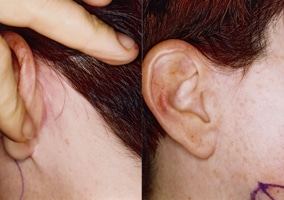
Typical near-invisible facelift scars produced by Dr. Haworth.

Typical near-invisible facelift scars produced by Dr. Haworth.
5. WHAT IS FIBRIN GLUE?
This is a true advance in facelift surgery in that it dramatically reduces the postoperative bruising and swelling associated with the procedure. As an added benefit, it allows the surgeon to forgo the use of annoying drains after surgery while virtually eliminating the chance of hematoma formation. It is a human-derived plasma product tested for HIV and hepatitis and used extensively in cardiac and neurosurgery. In facelift surgery, it is sprayed on all the raw surfaces to seal off most blood vessels and lymphatic channels not visible to the naked eye. This latter effect accounts for the rapid initial recovery seen in my facelift patients along with my use of electrocautery to perform most of the dissection. Electrocautery dissection eliminates most blood loss during surgery, further minimizing postoperative bruising and swelling.
6. HOW LONG IS THE SURGERY AND WHAT ARE THE THE MOST COMMON RISKS WITH IT?
A regular facelift without browlift, eyelid or lip surgery takes about 3 to 3.5 hours to perform. A midface lift takes about one hour to perform. With modern anesthesia it is all exceptionally safe surgery, however, regular facelift surgery patients need to be monitored by a healthcare professional for the first night after the procedure. This is most commonly done in a specialized aftercare facility. The reason for this is to check for the early signs of a hematoma (a blood collection under the facial skin), probably the most common complication after a facelift. Despite it being a very rare occurrence (especially with the use of fibrin glue), it is important to catch it early if it does occur so that it can be corrected rapidly.
7. WHEN CAN I GO IN PUBLIC?
Most patients are “restaurant-ready”, perhaps with some strategic coverup in about 7-10 days. This time period will be longer if you get your lips enhanced at the same time. Most stitches are removed at 5 days and the last hidden ones are removed at 10.
8. HOW MUCH PAIN WILL I BE IN DOCTOR?
Actually, very little. All facial procedures (including regular and midface lifts) are normally associated with some degree of numbness, stiffness and tightness. Stiffness with minor impairment of your full denture smile can last up to 3 months while sensation starts returning after a couple of weeks. Despite the lack of pain we still administer pain medicine just in case you need it.
9. WILL I LOSE ANY HAIR?
With the modern techniques of facial rejuvenation and specialized modifications that I have developed, hair loss is a very rare occurrence. However, if a small patch of hair loss develops it is an easy thing to correct.
10. HOW LONG WILL MY FACELIFT LAST?
Regular facelifts last from 7-12 years, depending on the individual’s tissue makeup. It is not that facelift suddenly falls apart at 12 years, but you will gradually note that the general signs of aging start to catch up again around this time. “Plastic surgery reverses time, but time still marches on.” – Dr. Haworth.



